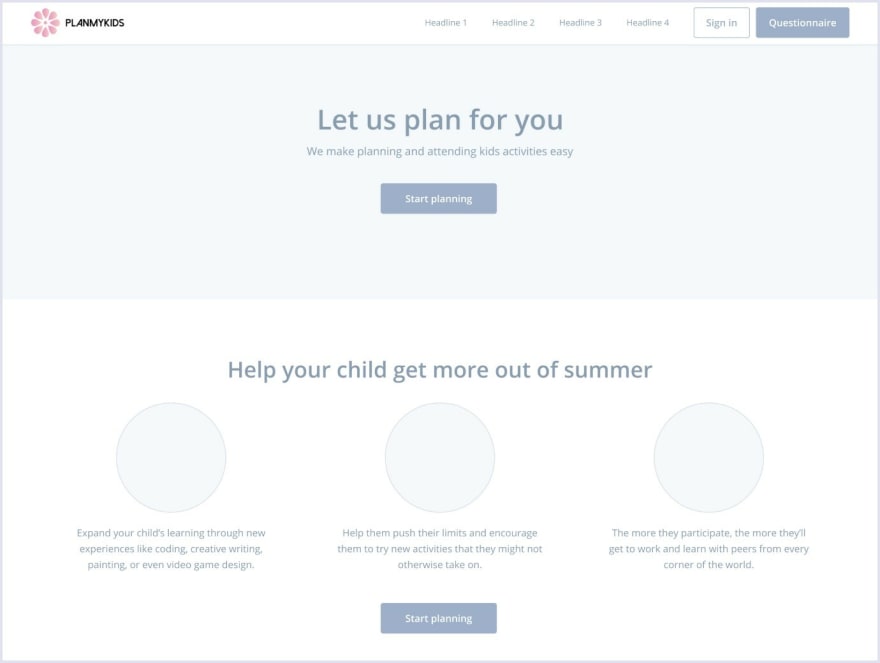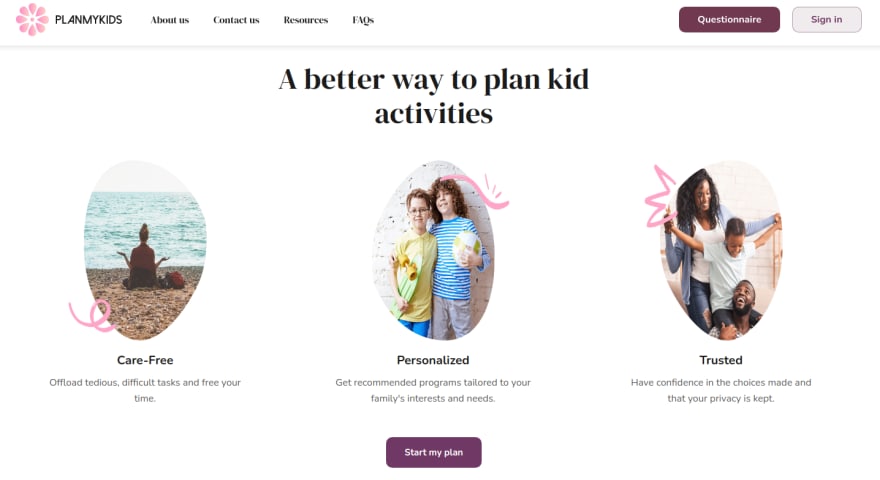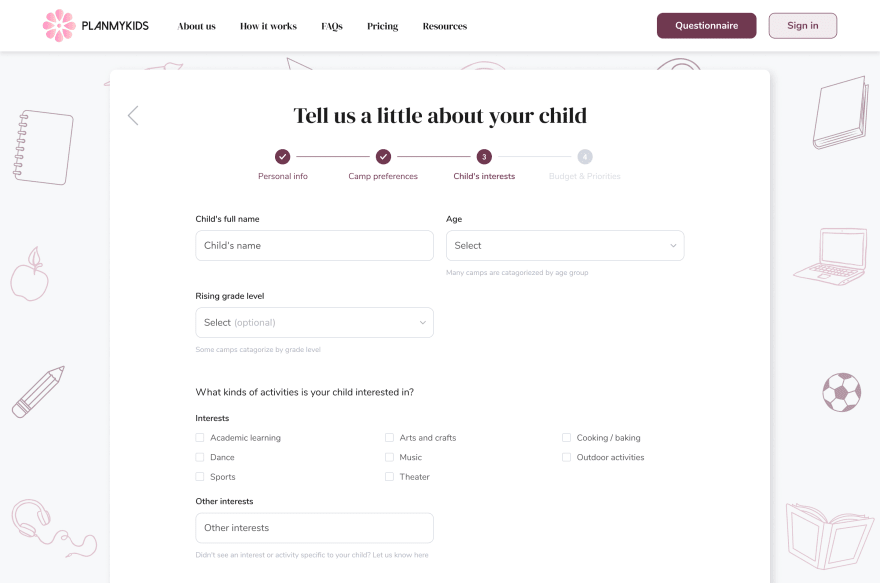The original article was published on Codica blog.
Our turbulent life is dictating new rules for many issues and daily tasks, especially for working parents. One of them is how to keep your kids busy and motivated after school. The problem is not only to find the activities of interest nearby but also to schedule and monitor them on the move.
An activity booking platform is an answer for this pressing matter. Such a solution helps parents and service providers schedule and coordinate the activities in no time.
We would like to tell you about our recent experience in developing an online booking platform for kids in detail. We’ll share the entire development process from the product discovery session till actual delivery.
What is behind the idea of the PlanMyKids project?
The idea comes first when you start building something new. However, a cool idea alone doesn’t make a startup profitable. So what is the plan? You can start by checking if your idea is solving any daily problems.
For example, Yelp’s Founder, Jeremy Stoppelman, took advantage of such an approach to solve his own problem. When he fell ill and could not find a doctor’s recommendation online, an idea of the review website appeared. Since this idea solved a real problem, it was in high demand and brought $233,2 million in revenue at the end of 2020.
The situation with the activity planner startup of our customer was pretty much the same. The idea provided a solution to the real problem. David, the Owner of the PlanMyKids activity booking platform, could not find the proper leisure activities for his own kids. Being a working parent means being short of time. The information he could find was not structured and required some extra coordination skills. As it turned out, he was not alone to face this issue. Many other parents were unsatisfied with the spare-time activity process for their kids.
With a deep understanding of the problem and with a strong vision of the future project, David started to look for a development team to help him out. He found Codica while doing online research and selected our team to work with because we have good experience in:
- Marketplace development services;
- Minimum viable product development;
- PWA development services;
- Expertise in Ruby and Ruby on Rails skills;
- Proficiency with Amazon cloud;
David submitted the form on our website and our journey began.
Product discovery stage
The product discovery stage is one of the most important stages to our minds. It helps start a new project in a smart way: identifying all risks, constraints, technology stack, and functionality involved.
Find below a detailed chat on why it is important to start off with a product discovery stage.
We had many product discovery sessions while working on PlanMyKids with David. The main aim was to collect all possible information. It helped us accomplish the following goals:
- Explore the subject area;
- Define the requirements for the system;
- Prepare the list of must-have MVP features;
- Identify all possible bottlenecks;
- Offer solutions to possible challenges;
- Provide architecture solutions best suited for the platform requirements.
On specifying all the details, we formed the scope of works, the workflow for every platform role, and a tech stack. Finally, we provided David with all related documentation, accurate time, and budget estimation.
Business logic
PlanMyKids platform has a smooth workflow for each of 3 types of users:
- Guardian/Parents;
- Specialists/Service providers;
- Admin
As an extra, we integrated a Family Questionnaire workflow, developed by the customer’s team.
Among the competitive advantages, our customer concentrated on:
- Simple planning;
- Intelligent watch;
- Easy participation of providers.
Tech requirement & stack
On finishing with business logic, we came up with the list of the core tech requirements. They were:
To build a fast, secure app, optimized for web and mobile. We chose PWA technology since it saves costs on native apps development.
To research and suggest the best solution for payment gateways integration.
Since we were building a minimum viable product, we needed to implement only must-have features.
Social login via Facebook or Google was required.
We offered the most in-demand tech stack to build a fast-loading, secure, and scalable activity booking platform:
- React;
- Rails API;
- Redis;
- AWS;
- Redux;
- Sidekiq.
Prototyping
Why is prototyping the best way to validate a user experience before moving to the development stage? First off, a prototype helps build a website structure based on the initial idea.
In the context of PlanMyKids, we wanted to show the customer how his future online marketplace will look for both parents and service providers.
We started with a general website structure, followed by workflows for all the roles, and their interaction on the platform.
Here comes the earliest version of the marketplace prototype:
As a result, this prototype showed the placement of interface elements on a future website.
Product design stage
The next stage is product design. Here we follow the latest design guidelines and make certain that all projects are easy-to-use and visually appealing.
Designing PlanMyKids, we focused on making it eye-catching and neat. Taking into account that the target audience was working parents, we wanted to make the website’s structure convenient and clear.
Let us share how we implemented the best UX/UI design practices in this product.
Best UX design practices
As for UX, this marketplace was created super user-friendly with simple and intuitive navigation.
We made sure that users can find all important information fast and with no extra actions. For example, you can find the Questionnaire at the top of the page, so parents can notice it right away.
Best UI design practices
UI comes next. PlanMyKids is a marketplace for children so we tried to make it not so official. This approach can be read in the graphic design, colors, and images. Our design team carefully selected the color scheme for the website, so it could be both elegant and playful. Have a look below.
MVP development stage
The customer decided to go on with MVP development. This approach involves fewer risks and allows businesses to start fast. So our main task here was to help David narrow down the features list to the sufficient minimum.
In the Product Discovery sessions, we singled out three roles on the platform and the workflow to every specific role. It helped us understand what are the must-have functionality for Admin, Parent, and Service Provider roles.
For example, below is a workflow for a role of a Parent:
- A Parent fills in the Survey.
- The Service provider receives the request from a Parent for an itinerary.
- The options are automatically selected by the platform.
- The Service provider checks the activities’ availability and sends the itinerary to a Parent for approval.
- A Parent can make changes to the itinerary (if needed). When the activities for children are relevant, the Parent can book and purchase them.
Based on the above workflow, the basic features set for Parents are:
- Questionnaire;
- Profiles;
- Calendar;
- Itinerary;
- Payment gateway. To have a closer look at every key functionality we delivered, please check the original article on Codica blog.
Agile approach
Following the Agile approach, we divided the project scope into small parts or sprints. Such an approach is effective to bring new features in a planned, predictable manner. During every sprint review, our team tracks the progress and adds changes to the staging instance. At the end of every sprint, we conduct a retrospective. It helps to find out if there are any issues.
Thanks to this approach transparency, the client could see all the project’s updates.
QA, maintenance, support
Prior to delivering the final solution to David, we made sure it works like a clock. Our experienced QA engineers double-checked every functionality, performing both manual and automation tests.
As of today, the PlanMyKids activity booking platform is on our regular support, so we can monitor its performance in a 24/7 format. Once David decides to add extra features to the product, we’ll be happy to assist. Find below David’s review of our work on his product.
Final words
Owing to effective communication on the project and professional teamwork, we were able to consult, research, design, deliver and support the high-load PWA platform for our client from scratch.
You are welcome to read a brief version of this online booking platform for kids in a Case study.
Are you looking for a reliable software development partner who can guide you all from the Product Discovery to the Support stages? Keep us in mind. Codica team has delivered many successful projects of different complexity. Contact us to discuss your idea.
For more information, read the full article: How We Delivered MVP for PlanMyKids - Kids Activities Marketplace (Case Study).









Top comments (0)